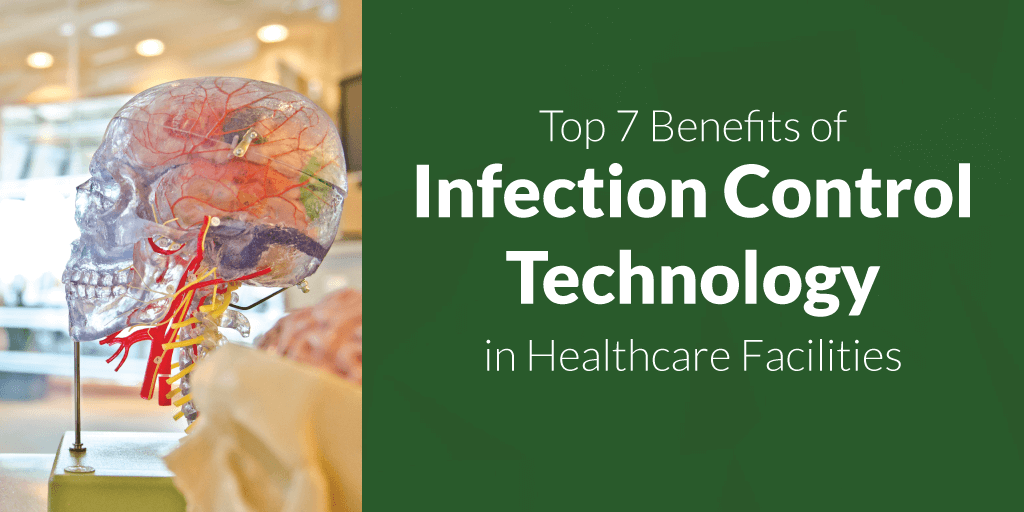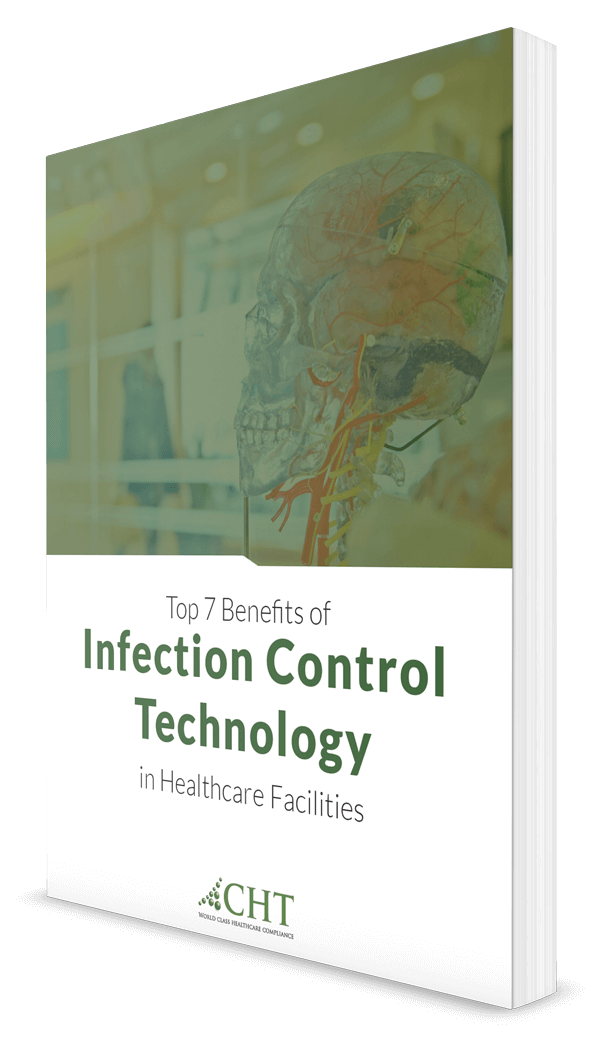
Infection control and prevention is a global issue. Thought-out and proven strategies are vital drivers of successful infection control in healthcare facilities.
Evolving technologies help control the spread of disease and help minimize HAIs. There are tremendous benefits when a facility takes the necessary steps to prevent the spread of infectious diseases.
As healthcare facility managers, our goal is to keep patients safe and be on the lookout for technology factors that will enhance facilities. We gathered the top 7 benefits of infection control technology for your environment and facility.

1. Life-Saving and Cost-Effective
Infection-detecting devices are at the forefront of this issue. A procalcitonin test (PCT) is the best-studied sepsis biological marker and an example of detection technology at its finest.
Sepsis, a strong reaction to a bacterial infection that spreads via the bloodstream, is more common in older adults and newborns. High levels of procalcitonin are a good indicator of or can suggest a risk of sepsis.
This test measures the procalcitonin level in the blood, as PCT is highly specific to bacterial infection.
Dr. Sean-Xavier Neath, M.D., Ph.D., assistant clinical professor of emergency medicine at UC San Diego Medical Center, said:
PCT provides a baseline of how sick a patient was when he or she came in, and from that, it can help inform treatment choices to ensure the best outcome.
In a 2016 study conducted by Sepsis Alliance News, the annual cost of hospital treatment of sepsis has grown by $3.4 billion.
The PCT tests play a key role in treating sepsis once diagnosed. It provides an excellent benefit for the patient and is cost-efficient for hospitals. Otherwise, untreated sepsis may result in extended hospital stays.
On another level, other technologies take the lead in reducing sepsis.
Sepsis has the potential to progress quickly, so early detection and treatment are critical to a patient's outcome. Ascom, a global solutions provider focused on healthcare ICT, built the Ascom Healthcare Platform software. This software supplies a wealth of information from patient-room equipment. Hospital staff can quickly assess incoming alarm notifications from a patient when speed and timing are critical.
It lets users securely access, interact with, and share information from devices, patients, machines, colleagues, and enterprise communication systems."
Watch below as the Ascom Myco 2 phone brings together data and alerts from EMR, Nurse Call, Patient Monitoring, and other systems in one intuitive smart device.
In short, a test or workflow with intelligent sharing is essential for reducing sepsis complications and costs.
2. Shift to Minimally Invasive Procedures
Innovations in technology have shifted towards minimally invasive procedures. This is excellent news for a patient because there are fewer risks associated with this type of surgery.
Surgery done through smaller incisions is typically considered safer. As a result, there is a growing number of spinal non-fusion procedures because of the beneficial outcomes for patients. Streamlined operations provide better care to patients.
Better surgical care equals lower complications.
Lower complications equals lower infection rates.
Another prime example is the robotic surgical system - da Vinci® Surgical System. It allows surgeons enhanced visualization, the ability to make smaller incisions, and have more control and precision. The patient benefits from faster recovery time and lower risk of infection.
3. Improve Workflow: Coordination with Other Departments
For infection control objectives to work best, healthcare facilities must coordinate with other departments.
An EHR (electronic health record) is a real-time, digital version of a patient's record. Athena Health states:
Electronic health records have been proven to improve workflow and patient care.
Athena Health offers healthcare IT services for medical groups. They believe the EHR keeps the focus on patient care.
In their annual survey, Physician Sentiment Index (PSI) and Sermo discovered that:
81% of physicians said they believe EHRs improve access to clinical data. More than two-thirds said an EHR can actually improve patient care.
By utilizing EHRs, healthcare facilities can keep the focus on providing the best possible care for their patients.
4. Explore Design Options for Infection Control
Virtual reality technology will allow experts to test out a space and see if it is conducive to preventing infection. As we design the hospitals of tomorrow, these evolving technologies can help guide us with the necessary layouts and modifications.
A great example would be to examine the layout of hand hygiene.
Is the space you are considering conducive to healthy hand hygiene? This type of sanitation directly affects a facility's ability to prevent infections.
A quick look at the difference between facilities with a high incidence of HAIs and those with lower than average incidence seemed to be:
Care providers clean their hands before and after caring for every patient.Up to 69% of hospital-acquired infections are preventable through known quality measures, specifically better cleaning and hand hygiene.
5. Preventing the Spread of a Disease With RTLS
Proven information technology such as RTLS (Real-time Location System) can improve facilities for both patients and staff.
Hospital-acquired infections are a constant threat to healthcare facilities. Centrak Security Solutions offers "the ability to keep a watchful eye on hand hygiene compliance and the ability to create contact tracing reports based on knowing when and which staff members and patients have come into contact with an infected person or asset."
They go on to explain how keeping track of all of a patient's movements and contacts can create a database of valuable information. According to Centrak,
In the event of an infectious outbreak, it is important to be able to trace every person or entity that has potentially come in contact with the disease. Patient tracking systems collect data that can be used retroactively to track the spread of disease within the facility.
Managing facility-wide infection outbreaks is critical.
Ari Naim, president and CEO of CenTrak, states that the strategic implementation of an RTLS system "can improve a hospital's readiness to protect patients, staff, and the surrounding community from an infectious disease outbreak." [source]
6. Medical Scope Management
With the potential for disease, medical scope management can help track usage, cleaning, and storage. This helps prevent infection and reduces medical scope damage.
Management like this will instantly alert staff of a missed sterilization process at any given point.
In a recent article by Chad Terhune of Kaiser Health News, "hospitals and device makers still struggle to rid medical scopes of infectious bacteria...71% of reusable medical scopes [that are] deemed ready for use on patients tested positive for bacteria."
Infections can pass from one patient to the next if not adequately cleaned.
There are standards and regulations in place to reduce the risk of infection. Here are a few from the American National Standards Institute/Association for the Advancement of Medical Instrumentation:
ANSI/AAMI ST79: 2017 - The comprehensive guide to steam sterilization and sterility assurance in healthcare facilities.
ANSI/AAMI ST58:2013 - Chemical sterilization and high-level disinfection in healthcare facilities.
ANSI/AAMI ST91: 2015 - A guide to flexible and semi-rigid endoscope processing in healthcare facilities.
A presentation conducted by Mary Ann Drosnock, Manager of Clinical Education for Gastroenterology, and Steve Kovach, Director of Education, Healthmark Industries, discusses the tools and challenges of testing verification.
Are Your Scopes Dirty? Challenges of Testing Verification
[Becker's Hospital Review]. (2015, December 8). Are Your Scopes Dirty? Challenges of Testing Verification [Video File]. Retrieved from https://www.youtube.com/watch?v=TQJgtvUJVcA
Training of staff is critical.
Every facility needs to adopt a policy that is right and helps them stay within compliance and standards.
7. Ultraviolet Light Technology: The Power of Light
Jim Gauthier, senior clinical advisor of infection prevention at Diversey, clearly states how the environment plays a role in the spread of infection.
It is estimated that 20-40% of HAIs result from transmission of pathogens by a healthcare worker after touching another patient or a contaminated surface. [source]
Ultraviolet-C (UV-C) programs can help eliminate bacteria that manual processes may miss. Healthcare environments are adding UV-C programs due to the inconsistency of manual cleaning, and antibiotic organisms are becoming more resistant and surviving on surfaces much longer.
According to the American Journal of Infection Control, it is an ongoing battle against health-acquired infections. This has led to the widespread acceptance there is a direct need for both manual/traditional cleaning and a secondary procedure/technology.
UV-C technology may be the answer.
Interested in UV-C? Below are articles that go in-depth about how UV-C works and is implemented.
- What is UV-C Light and How Does it Work?
- Ultraviolet C Light Technology: Effective or Waste of Money?
- New Type of Ultraviolet Light Makes Indoor Air as Safe as Outdoors.
The results?
Hospital-acquired infections have decreased each year since implementation.
Conclusion
Technological advancements and innovations will help healthcare facilities improve preparedness and reduce infectious disease outbreaks.
CHT provides innovative technology to help healthcare facilities start to control and manage their medical gas systems. This, in turn, will ensure your healthcare compliance.




